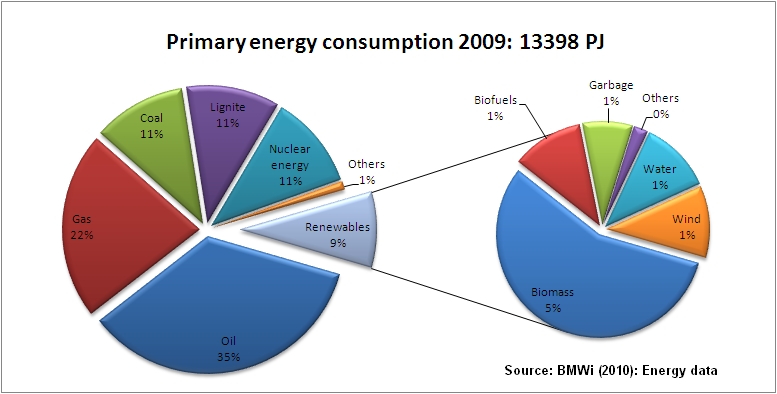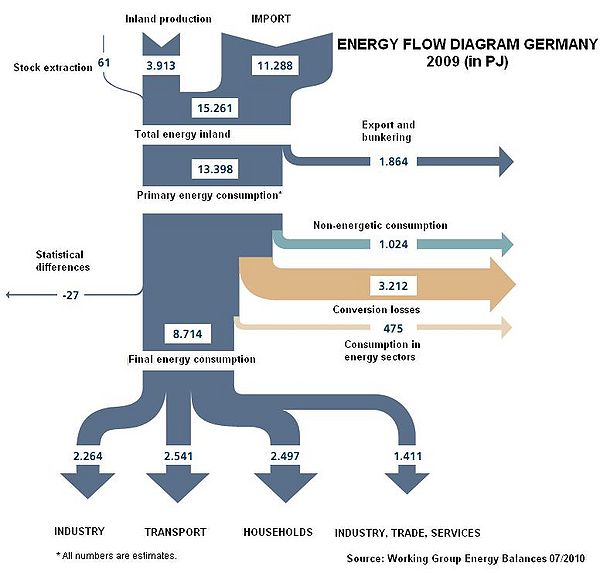Difference between revisions of "Germany Energy Situation"
***** (***** | *****) |
***** (***** | *****) |
||
| Line 28: | Line 28: | ||
== Electricity situation == | == Electricity situation == | ||
| + | |||
| + | Needless to say, in comparison to developing and even emerging countries the German electricity sector is very proficient and works reliably. Power outage rates rank among the lowest in the world . | ||
| + | |||
| + | '''Supply:''' | ||
| + | |||
| + | Currently, the installed capacity of German power plants lies in the range of 143,3 GW electrical power. This means if capacity factors were assumed to be 100% (i. e. all power plants are in use throughout the whole year) the maximum amount of electricity generation would be 1255.3 TWh/year (143,3 GW x 8760h). Clearly, this is unrealistic due to high variable costs of power plants that are specifically designed to serve intermediate and peak loads only. Additionally, power plants depending on renewable energies like wind or solar radiation cannot decide when to generate. | ||
| + | |||
| + | In reality, German electricity generation amounted to 597 billions kWh (= 597 TWh) in 2009 which lies in the range of emerging countries like Brazil or India.<ref>cf.International Energy Agency (2010): Key World Energy Statistics, pp. 48-57.</ref> This shows that the true value of the aggregated average capacity factor lies around 50%. Whereas nuclear, lignite and hydro power plants virtually run all the time to supply the base load, other electricity plants (such as coal and gas) only serve intermediate load. Peak load is mainly provided for by pumped-storage power plants and oil-fired power plants. To produce the abovementioned amount of electricity, fuels with an energy content of 5227 PJ were used in German power plants (~39% of primary energy consumption). | ||
| + | |||
| + | Electricity generation in Germany is still based to a very large extent on coal. The generation mix in 2009 consisted of 28% from nuclear power plants, 26% from lignite, 18% from coal, 11% from gas and about 16% from renewable energies. The following diagram provides a brief overview of the situation. It should be noted that the share of renewable energies in electricity generation is considerably greater than in primary energy consumption. This can largely be attributed to the incentives created by the German Renewable Energy Law of 2000. | ||
== Policy framework, laws, regulations == | == Policy framework, laws, regulations == | ||
Revision as of 09:11, 7 October 2010
When looking at the energy/electricity situation of developing countries around the world it is always helpful to have in mind a reference point for a better understanding, analysis and judgement of the respective challenges in the case at hand. The country situation Germany should help to provide this critical positioning.
This article first briefly discusses the present energy situation in Germany in general terms, before adressing in more detail the electricity sector and recent political endeavours that link climate protection and long-term sustainable energy supply.
Energy Situation:
Primary energy consumption
Primary energy denotes the state of energy before any conversion or transformation process towards a more valuable energy form has taken place (e. g. solar energy, wind energy, fossil fuels, hydro power, nuclear fuels, biomass etc.). Primary energy consumption relates to the entire amount of primary energy used by an economy in a certain time period (usually a year).
In Germany, primary energy consumption in 2009 amounted to 13398 PJ (= 3720 TWh). Although there has been a sharp decline in petroleum product consumption since 1995 (-14,4%), it still remains the most important primary energy carrier representing about a third of total primary energy consumption. Similarily, coal consumption has been decreasing during the last 10-15 years, but remains an important primary energy carrier. A substitution process in the direction of an increasing gas consumption has accompanied the decrease in consumption of the beforementioned energy sources.
Germany is a net importer of primary energy with an increase of imports from 57% in 1990 to 70% in 2008.[1] This situation underlines the high degree of energy dependence the German state faces. The rising import quotas can largely be attributed to a rising demand of gas and substitution processes of German coal through coal from international markets.
The following diagram offers an overview of the share of different energy carriers in primary energy consumption:
The following energy flow diagram offers insight into the shares of different sectors in total primary energy consumption in 2009. Very prominently, it visualizes the high degree of dependence on energy imports (~70%). Furthermore, it shows that approximately 25% of primary energy consumption are lost in conversion processes. Out of the 13398 PJ of primary energy consumption only 8714 PJ are available for final energy consumption. Final energy consumption is quite evenly distributed among the three sectors industry, transport and households. Only trade and services represent a minor share.
Electricity situation
Needless to say, in comparison to developing and even emerging countries the German electricity sector is very proficient and works reliably. Power outage rates rank among the lowest in the world .
Supply:
Currently, the installed capacity of German power plants lies in the range of 143,3 GW electrical power. This means if capacity factors were assumed to be 100% (i. e. all power plants are in use throughout the whole year) the maximum amount of electricity generation would be 1255.3 TWh/year (143,3 GW x 8760h). Clearly, this is unrealistic due to high variable costs of power plants that are specifically designed to serve intermediate and peak loads only. Additionally, power plants depending on renewable energies like wind or solar radiation cannot decide when to generate.
In reality, German electricity generation amounted to 597 billions kWh (= 597 TWh) in 2009 which lies in the range of emerging countries like Brazil or India.[2] This shows that the true value of the aggregated average capacity factor lies around 50%. Whereas nuclear, lignite and hydro power plants virtually run all the time to supply the base load, other electricity plants (such as coal and gas) only serve intermediate load. Peak load is mainly provided for by pumped-storage power plants and oil-fired power plants. To produce the abovementioned amount of electricity, fuels with an energy content of 5227 PJ were used in German power plants (~39% of primary energy consumption).
Electricity generation in Germany is still based to a very large extent on coal. The generation mix in 2009 consisted of 28% from nuclear power plants, 26% from lignite, 18% from coal, 11% from gas and about 16% from renewable energies. The following diagram provides a brief overview of the situation. It should be noted that the share of renewable energies in electricity generation is considerably greater than in primary energy consumption. This can largely be attributed to the incentives created by the German Renewable Energy Law of 2000.
Policy framework, laws, regulations





















